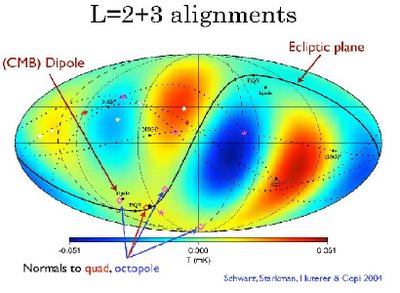Hearty congratulations to John C. Mather and George F. Smoot, who have just received the 2006
Nobel Prize for their leading roles in the
COBE experiment measuring the CMBR.
Yesterday I was reading a new book by Joel R. Primack and Nancy Ellen Abrams,
The View from the Center of the Universe. This book has a commendable grand vision: to look at how the current revolution in cosmology can benefit humanity as a whole by altering its conception of Nature itself. Primack was apparently one of the physicists who predicted the anisotropy of the CMBR, based on the existence of Dark Matter. Despite the book's relatively conservative, and hence quite erroneous, view of current cosmology, it offers brilliant physical insights in a very accessible way. I would like to quote a little:
We don't normally think of reality as funnelling from great galaxy clusters into us and spreading cell to cell, then soaring inward to the molecular level, the atomic, the quantum levels - and our humanness the fulcrum at the centre of the entire process. But we need to. We need to experience the universe from the inside. We have to imagine ourselves in our proper place, inside the symbols, part of the symbols, the point of the symbols.There is also a reasonable discussion about the celestial sphere, the badly named
surface of last scattering, and how this returns us in some sense to a cosmology with Earth at the centre, but in a way that the Greeks could never have imagined. In the standard modern cosmology (the one that is purported to be revolutionary) this celestial sphere is a fixed surface in a concrete reality that, despite Primack's promises, the mathematics has not escaped. We continuously receive light from this primordial sphere. Compare the
COBE results to those of the more recent
WMAP satellite. The blotches look roughly the same. Over great lengths of time on Earth it is supposed that the light reaching us will become more and more redshifted as the concrete universal spacetime itself expands.
There are
other, even more profound, possibilities. If we accept that the temperature of the CMBR is an indicator of cosmic
epoch, then its measurement is a kind of clock. The consequences of this simple observation are not considered in the standard cosmology.
The local standard for
time is now the
cesium clock, which is accurate to an incredible 2 nanoseconds per day or, equivalently, one second in 1400000 years. A
second, by definition, is precisely the time it takes for 9192631770 cycles of microwave light (of a particular wavelength) from cesium133 atoms in their ground state to be absorbed or emitted. Observe that this definition requires only counting (of cycles) and an understanding of the measurement of wavelength.
In the overzealous use of the basic equations of GR people have forgotten that it was the mathematician Minkowski who packaged spacetime neatly into a box all tied up with string. It has always been physically clear that
time and
space, though necessarily related, are conceptually distinct.




 The evidence for life on earth dates back to the oldest rocks on earth, namely the Akilia island sediments of West Greenland. Although the evidence in carbon isotopes for life in these particular sediments has been open to question, there is plenty of evidence in other ancient rock sediments which typically date life back 3.55 billion years.
The evidence for life on earth dates back to the oldest rocks on earth, namely the Akilia island sediments of West Greenland. Although the evidence in carbon isotopes for life in these particular sediments has been open to question, there is plenty of evidence in other ancient rock sediments which typically date life back 3.55 billion years. It is a broken pentagon, but the top side is an identity if we want the sequence to form a 1-operad in the usual sense. Otherwise, the sequence of permutohedra form a kind of non-commutative operad. Moreover, there is a map of operads from these permutohedra to the diagrams with collapsing identities. This was outlined concretely by Loday.
It is a broken pentagon, but the top side is an identity if we want the sequence to form a 1-operad in the usual sense. Otherwise, the sequence of permutohedra form a kind of non-commutative operad. Moreover, there is a map of operads from these permutohedra to the diagrams with collapsing identities. This was outlined concretely by Loday.